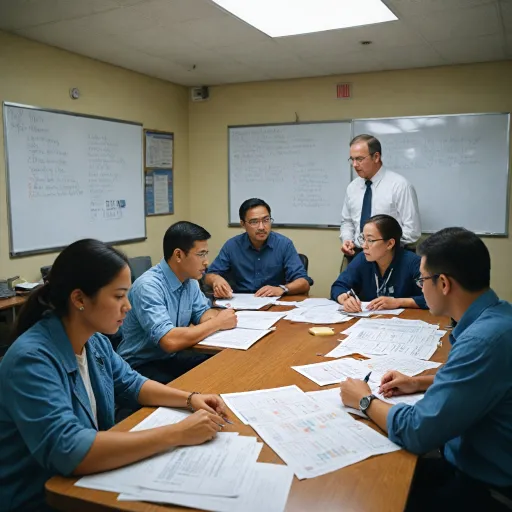
Understanding Skills Gap Analysis
Defining the Skills Gap
Understanding the skills gap is the first step in addressing it effectively. A skills gap occurs when there is a disparity between the skills that employees currently possess and the skills needed to achieve business goals. This gap can hinder performance and slow down the development of both individuals and organizations.
Identifying Key Areas for Improvement
Conducting a skills gap analysis involves identifying the specific areas where skills are lacking. This process helps in pinpointing the gaps that need to be filled to meet current and future business objectives. By identifying these gaps, organizations can create targeted training programs and development plans to enhance employee performance.
Steps to Conduct a Skills Gap Analysis
- Define Business Goals: Clearly outline the business objectives that need to be achieved. This will guide the identification of necessary skills.
- Assess Current Skills: Evaluate the current state of employees' skills and knowledge. This can be done through surveys, interviews, or performance reviews.
- Identify Skill Gaps: Compare the current skills with the skills needed to achieve business goals. This will highlight the gaps that need attention.
- Create an Action Plan: Develop a strategy to address the identified gaps. This may include training programs, hiring new talent, or reallocating resources.
The Importance of a Skills Gap Analysis Template
Using a skills gap analysis template can save time and ensure a structured approach to identifying and addressing skill gaps. Templates provide a framework for systematically evaluating skills and developing action plans. While there are free templates available, customizing them to fit the specific needs of your organization can lead to more effective outcomes.
In the next sections, we will explore how AI can enhance this process, offering innovative solutions and tools to streamline skills gap analysis and implementation.
The Role of AI in Skills Gap Analysis
AI's Transformative Role in Skills Gap Analysis
Artificial Intelligence (AI) is revolutionizing how organizations approach skills gap analysis, making it more efficient and insightful. By leveraging AI, companies can identify skills gaps with greater precision and develop targeted training programs to address them.
Enhancing Data Collection and Analysis
AI tools can process vast amounts of data quickly, providing a comprehensive view of an organization's current skills landscape. This capability allows HR professionals to conduct skills gap analysis more accurately, identifying both hard and soft skills gaps among employees. By analyzing performance data and employee feedback, AI can pinpoint areas where skills development is needed, saving time and resources.
Predictive Insights for Future Skills Needs
One of the most significant advantages of using AI in skills gap analysis is its predictive capabilities. AI can forecast future skills needs based on current trends and business goals. This foresight enables organizations to proactively develop training programs and action plans, ensuring employees are equipped with the skills needed to meet future challenges.
Personalized Learning and Development
AI-driven solutions can tailor learning and development programs to individual employees, addressing their unique skills gaps. By analyzing an employee's current skills and performance, AI can recommend personalized training paths that align with both personal and organizational goals. This personalized approach not only enhances employee engagement but also improves overall performance.
Streamlining the Skills Gap Analysis Process
AI can automate many aspects of the skills gap analysis process, from data collection to generating analysis templates. This automation allows HR teams to focus on strategic decision-making rather than administrative tasks. By using AI-powered tools, organizations can create free templates that streamline the skills gap analysis process, making it more accessible and efficient.
In summary, AI plays a crucial role in modernizing skills gap analysis. Its ability to process data, predict future skills needs, and personalize learning development makes it an invaluable tool for organizations looking to bridge skills gaps effectively.
Developing a Skills Gap Analysis Template with AI
Creating a Tailored Skills Gap Analysis Framework Using AI
Crafting a successful skills gap analysis framework is an essential step in identifying and bridging gaps between the current skills of your workforce and the skills needed to achieve business goals. By leveraging AI, businesses can customize templates that align with their unique requirements, saving time and improving accuracy. When developing a skills gap analysis template, AI can assist in several ways:- Data Collection and Organization: AI technologies streamline the process of collecting and organizing data relevant to employee performance, allowing for a comprehensive understanding of areas where skill gaps exist. AI can quickly analyze current state data to identify gaps in both hard and soft skills.
- Customizable Analysis Templates: AI allows for the creation of analysis templates that are customizable to various departments or teams. This flexibility ensures that the templates consider specific skills and learning development needs of different areas within the organization.
- Predictive Insights: By analyzing historical data, AI can offer insights into the skills that will be essential for future roles, aligning training and development initiatives with strategic business goals.
- Free and Accessible Resources: There are numerous free templates available that employ AI capabilities to refine the process of conducting skills gap analysis. These tools can offer a head start in addressing skill gaps without significant investment.
Implementing AI-Driven Solutions
Implementing AI-Driven Solutions for Skills Gap Analysis
Once you've identified the skills gaps within your organization, the next step is to implement AI-driven solutions to address these gaps effectively. This involves a strategic approach that combines technology with human insight to enhance employee performance and align with business goals.
Creating an Action Plan
Developing a comprehensive action plan is crucial. This plan should outline the steps necessary to bridge the identified skills gaps. AI can assist in this process by analyzing the current state of skills within the organization and suggesting targeted training programs. By leveraging AI, you can save time and ensure that the training is aligned with the specific needs of your employees.
Personalized Learning and Development
AI can offer personalized learning and development opportunities by tailoring training programs to individual employees' needs. This personalization ensures that employees receive the right mix of soft skills and technical skills training, enhancing their overall performance. AI-driven platforms can continuously monitor progress and adjust learning paths to meet evolving skill requirements.
Monitoring Progress and Adjusting Strategies
Continuous monitoring is essential to ensure that the implemented solutions are effective. AI tools can provide real-time insights into the progress of skills development, allowing HR professionals to adjust strategies as needed. This ongoing analysis helps in identifying new skills gaps and ensures that the organization remains agile in its approach to workforce development.
Leveraging Free Templates and Tools
To facilitate the implementation process, consider using free templates and tools available online. These resources can help streamline the process of conducting skills gap analysis and developing action plans. By utilizing these templates, organizations can focus on strategic decision-making rather than getting bogged down in administrative tasks.
Incorporating AI into your skills gap analysis and development strategy not only enhances efficiency but also ensures that your workforce is equipped to meet future challenges. As you move forward, keep an eye on emerging trends in AI to continuously refine your approach and stay ahead in the competitive landscape.












